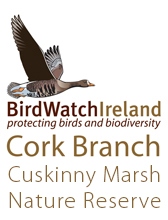Habitats
A phase 1 habitat survey of the reserve was carried out in March 2000.
Habitat classifications follow JNCC (1993).
The northern end of the reserve comprises a mixture of broad-leaved woodland, tall herb vegetation and swamp. Tall Alder, White Willow and Crack Willow and shrubby Rusty Willows dominate the woodland. While Crack Willow and White Willow are not Irish native species, they are widely naturalised, and the woodland does not appear to be of plantation origin; therefore, the woodland has been classified as semi-natural.
The upper section of woodland is quite dry and well-drained with an open ground layer of Common Nettle, Cleavers, Lesser Celandine, Common Couch, Creeping Buttercup, Smooth Meadow-grass, etc. Lower down, the ground becomes waterlogged with Hemlock Water-dropwort, Remote Sedge, Opposite-leaved Golden-saxifrage, Yorkshire Fog, Marsh Bedstraw, etc in the woodland ground flora. This waterlogged zone also holds open areas on both sides of the stream.
On the north side, the open area holds tall herb vegetation with patchy Common Reeds mixed with Hemlock Water-dropwort, Common Nettle, Willowherb, Meadowsweet, Soft Rush, Yorkshire Fog, Creeping Bent, Creeping Buttercup, etc. Scattered willow bushes occur and an artificial pond (approximately 20 m diameter) has been excavated in this area. On the south side of the river, Common Reed becomes dominant (causing the habitat to be classified as swamp). Along the eastern edge of this zone, on the north side of the stream, around 0.6 ha of the floodplain has been planted with conifers; these are now around 3 m high.




